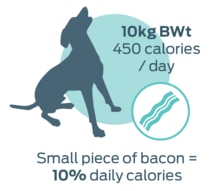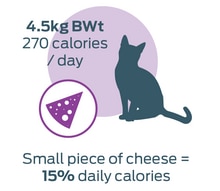

Excess Body Weight
The Role of Diet in Managing Excess Weight
A tailored nutritional approach can help overweight or obese pets lose weight.
Key Messages
- Calorie restriction based on the pet’s goal (ideal) weight is key to achieving weight loss, i.e., less calories consumed than used.
- Feeding a commercial weight loss diet offers complete and balanced nutrition while helping a pet lose weight.
- Commercial weight loss diets provide all the nutrients the pet needs in the right amounts and balance while providing fewer calories.
- Measuring the food can help ensure successful weight management. Weigh scales are the most accurate but measuring cups are also useful.
- Measuring the food reinforces this is the only food the pet should eat.
- When feeding dry kibbles, they can be divided into both meals with a portion used as treats.
- Since pets do not have identical maintenance energy requirements, each pet will respond differently to a weight loss diet.
- Body Condition Score and weight should be monitored so that the amount of food can be adjusted if needed.
- If additional treats are fed, they should not exceed 10% of a pet’s daily caloric intake.
- The quantity of the main meal food should be reduced to account for the treats. Treats can contain a surprising amount of calories.


- In multi-pet households, overweight pets should be fed separately and should not have access to other pets’ bowls.


Related Tools and Content:
The Purina Body Condition System
The Purina Body Condition System is an easy and practical tool for assessing a pet's body composition.
How to Perform a Body Condition Assessment - Cat
Assess a cat's Body Condition Score in just 3 simple steps.
How to Perform a Body Condition Assessment - Dog
Assess a dog's Body Condition Score in just 3 simple steps.
OBESITY IN PETS: Nutritional and Behavioral Strategies for Preventing and Managing Excess Weight
Preventing and managing excess weight can help dogs and cats lead better, and importantly, longer lives.
The Role of Diet in Managing Excess Weight
In this brief video, Michael (Mike) T. Robbins, DVM, DACVIM (Nutrition), explains why a tailored nutritional approach is required to help overweight or obese pets lose weight.
To Share With Pet Owner:
Feeding Pets for Weight Loss
Up to 63% of pet cats and 59.3% of pet dogs are overweight or obese, and this condition is linked with serious health risks. However, many pet owners do not recognize their dog or cat is overweight or how nutrition can help manage healthy weight–and a healthier life—for their pet.
Evaluating Your Cat’s Body Condition
Assess your cat's Body Condition in just 3 simple steps.
Feline Body Condition System Sheet
A visual aid to the Purina Body Condition Score System for cats.
Body Condition System Progress Chart Cat
The Progress Chart should be used with the Feline Body Condition System Sheet to help track a pet’s weight loss or gain.
Evaluating Your Dog’s Body Condition
Assess your dog's Body Condition in just 3 simple steps.
Canine Body Condition System Sheet
A visual aid to the Purina Body Condition Score System for dogs.
Body Condition System Progress Chart Dog
The Progress Chart should be used with the Canine Body Condition System Sheet to help track a pet’s weight loss or gain.
Additional Resource
Laflamme, D. P. (2006). Understanding and managing obesity in dogs and cats. Veterinary Clinics of North America: Small Animal Practice, 36, 1283–1295.